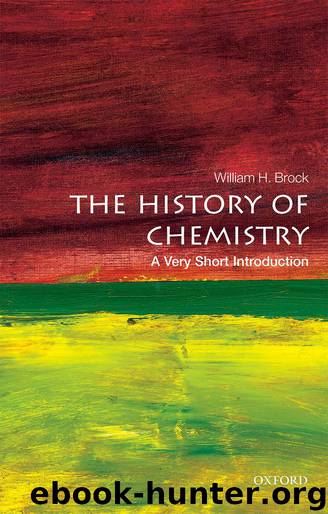The History of Chemistry: A Very Short Introduction by William H. Brock

Author:William H. Brock
Language: eng
Format: epub
ISBN: 9780198716488
Publisher: OUP Oxford
Published: 2015-12-04T05:00:00+00:00
Two French brigands
Charles Gerhardt (1816–56) had been trained and educated by his father to run a family white lead factory in Strasbourg, but Gerhardt fell so deeply in love with chemistry that he rebelled and took advanced studies with Liebig in Giessen and with Dumas in Paris. This led to a job in Montpellier, but disgusted with the poor facilities in such a provincial city he resigned in 1851, returned to Paris, and earned his living by private teaching in his own chemistry school. It was not until two years before his tragically early death that he was appointed a professor in his home town.
From 1844 onwards Gerhardt became a close friend of another rebellious chemist, Auguste Laurent (1808–53), who had trained with Dumas in Paris and worked in ceramic factories before teaching in Bordeaux. In 1846, appalled by the poor facilities at the University of Bordeaux, he joined Gerhardt in his school enterprise in Paris where they shared ideas about the reform of organic chemistry. Neither man respected Dumas, their former teacher, because he represented conservative chemical ideas and the establishment; both men were tactless and quarrelsome, but between them they transformed the way organic chemists viewed their chaotic subject.
By the 1850s, organic chemists were confident about the constitution and quantitative ratios of the elements composing an organic compound (though, in practice, their formulae might look different because there was no consistent system of atomic weights). By then chemists were also aware that elements ‘clumped’ together in regular patterns, and that there was an internal ‘order’ of elements within a compound, as indicated by the fact that the same empirical formulae had to be given to isomers that had distinctly different properties.
Berzelius had been a pioneer in differentiating the clumps within molecules by virtue of the dualistic system that, following Lavoisier’s inorganic system, he promulgated from 1818 onwards. According to this electrochemical system of classification, organic compounds consisted of a positive hydrocarbon radical electrically linked to a negatively charged molecule that might contain more carbon and hydrogen together with oxygen, nitrogen, and other elements. This classificatory model was known as the radical theory; organic chemistry, in the words of Liebig, differed from inorganic chemistry because it involved compound, rather than simple, radicals. The radical model has persisted into the 21st century in the idea of ‘groups’, though these are no longer laboriously identified by 19th-century methods of analysis, but by their optical signatures that can be read spectroscopically or magnetically.
An alternative way of viewing the constitution of organic molecules had also matured from the 1830s. This had been generated from a discovery by Dumas in 1834 that electronegative elements or radicals such as chlorine, bromine, and cyanogens could be exchanged or substituted for hydrogen, in what Berzelius interpreted as the electropositive hydrocarbon portion of a molecule.
For Dumas, substances of the same chemical type clearly contained the same number of equivalents united in the same manner because they underwent the same fundamental reactions. For example, acetic acid, CH3COOH could easily
Download
This site does not store any files on its server. We only index and link to content provided by other sites. Please contact the content providers to delete copyright contents if any and email us, we'll remove relevant links or contents immediately.
Alchemy and Alchemists by C. J. S. Thompson(3306)
The Elements by Theodore Gray(2860)
The Club by A.L. Brooks(2760)
How to Make Your Own Soap by Sally Hornsey(2752)
Drugs Unlimited by Mike Power(2490)
Wheels of Life by Anodea Judith(1928)
Cracking the Sat French Subject Test, 2013-2014 Edition by The Princeton Review(1774)
Perfume by Jean-Claude Ellena(1743)
The Flavor Matrix by James Briscione(1723)
Cracking the LSAT, 2012 Edition by Princeton Review(1700)
The Cosmic Machine: The Science That Runs Our Universe and the Story Behind It by Scott Bembenek(1694)
MCAT Physics and Math Review by Princeton Review(1571)
1000 Multiple-Choice Questions in Organic Chemistry by Organic Chemistry Academy(1571)
The Thing Around Your Neck by Chimamanda Ngozi Adichie(1498)
Handbook of Modern Sensors by Jacob Fraden(1482)
Cracking the SAT Premium Edition with 6 Practice Tests, 2017 by Princeton Review(1481)
Synchrotron Light Sources and Free-Electron Lasers by Eberhard J. Jaeschke Shaukat Khan Jochen R. Schneider & Jerome B. Hastings(1461)
A is for Arsenic: The Poisons of Agatha Christie (Bloomsbury Sigma) by Kathryn Harkup(1460)
Harry Potter All Books: 8 Books by J.k.rowling(1439)
